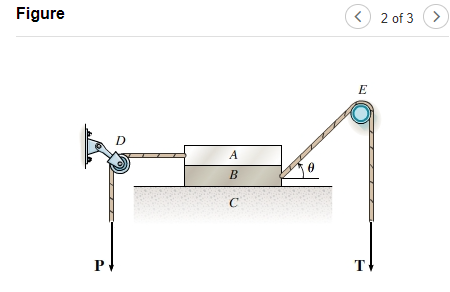Blocks A and B have a masses of 200 kg and 240 kg , respectively. (Figure 2) The coefficient of static friction between A and B and between B and C is 0.210. The coefficient of static friction between the rope and peg E is 0.430. Pulley D rotates freely, and P = 29.0 N . If 0 = 60.0 degrees , what is the smallest magnitude, T, of tension, T, that causes block B to move? Express your answer numerically in kilonewtons to three significant figures. • View Available Hint(s) Π ΑΣφ vec ? T = kN
Blocks A and B have a masses of 200 kg and 240 kg , respectively. (Figure 2) The coefficient of static friction between A and B and between B and C is 0.210. The coefficient of static friction between the rope and peg E is 0.430. Pulley D rotates freely, and P = 29.0 N . If 0 = 60.0 degrees , what is the smallest magnitude, T, of tension, T, that causes block B to move? Express your answer numerically in kilonewtons to three significant figures. • View Available Hint(s) Π ΑΣφ vec ? T = kN
Related questions
Question

Transcribed Image Text:Blocks A and B have a masses of 200 kg and 240 kg , respectively.(Figure 2) The coefficient of static friction between A and B and between B and C is 0.210. The
coefficient of static friction between the rope and peg E is 0.430. Pulley D rotates freely, and P = 29.0 N. If 0 = 60.0 degrees , what is the smallest magnitude, T, of
tension, T, that causes block B to move?
Express your answer numerically in kilonewtons to three significant figures.
• View Available Hint(s)
vec
?
T =
kN

Transcribed Image Text:Figure
<) 2 of 3
<>
E
D
A
P
T
Expert Solution
This question has been solved!
Explore an expertly crafted, step-by-step solution for a thorough understanding of key concepts.
This is a popular solution!
Trending now
This is a popular solution!
Step by step
Solved in 2 steps
